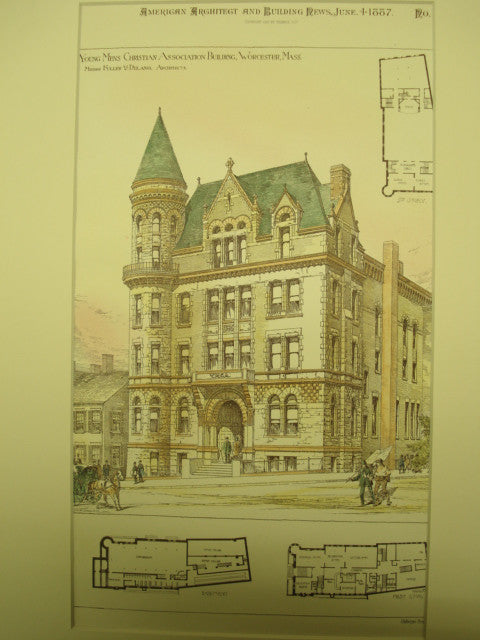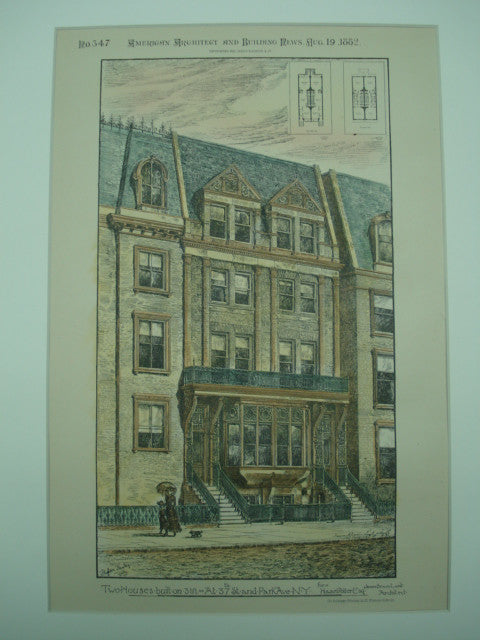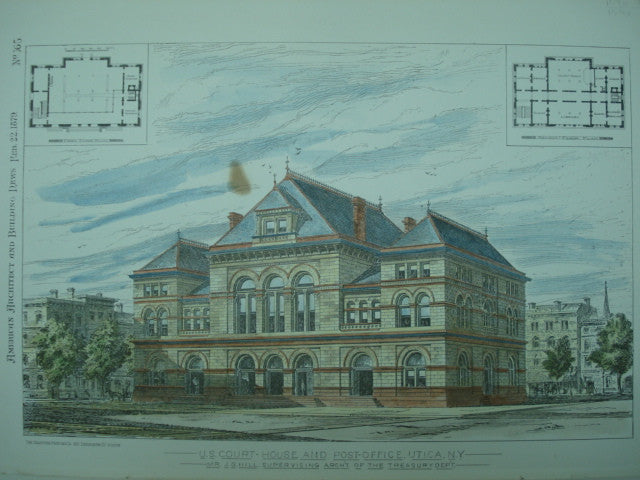News
Fine Dining and Athletics in 1887 August 28 2015
This is the twelfth installment in our series of posts comparing significant events from a year in United States history with a few of our unique architectural plans from the same period. 1887, the topic of this installment, subsequently marks the twelfth year of the American Architect and Building News' existence.
Click on the pictures to find the plans below in our store!
In New York City during the mid-nineteenth century, the Delmonico name was synonymous with fine dining throughout the nation. The family owned a number of restaurants throughout the city and was best known for pioneering the forever imitable Delmonico steak. Below is an 1887 plan for a new Delmonico's Restaurant at 341 Broadway in New York City, designed by prominent architect James Brown Lord. Though it is unclear whether this location came into existence, seeing Lord attached to the Delmonico name provides an interesting look at the influence the Delmonico family and their food had over the city.
The Young Men's Christian Association was founded by George Williams in mid-nineteenth century London. Williams was concerned about the lack of healthy activities for young men living in cities in the period soon after the industrial revolution and sought to provide new access for them. By the 1880s, the YMCA had spread throughout the Western world, providing opportunities for sportsmanship and athletic contests, as well as promoting evangelical Christian services. This 1887 plan for the Young Mens Christian Association Building in Worcester, Massachusetts designed by Fuller & Delano exemplifies the popularity and reach of the association in such a short amount of time. And this was just the beginning of the YMCA's storied history.
Electricity Begins and Poetry Ends in 1882 August 17 2015
This is the seventh installment in our series of posts comparing significant events from a year in United States history with a few of our unique architectural plans from the same period. 1882, the topic of this installment, subsequently marks the seventh year of the American Architect and Building News' existence.
Click on the pictures to find the plans below in our store!
Thomas Edison continued to shape the nation's history in 1882. To add to his list of ever-growing achievements, he established the world's first commercial electric power plant, giving electricity to an entire square mile of lower Manhattan. These two houses, at 37th Street and Park Avenue for Howard Potter, might have not been in that original lighted area, but were sure to soon feel the full effects of Edison's genius. They were designed by the master of the Beaux-Arts style, James Brown Lord.
On March 24, 1882, Henry Wadsworth Longfellow succumbed to peritonitis in his Cambridge, Massachusetts home in the company of his close family. The celebrated poet and Harvard professor was best known for his works The Song of Hiawatha and Evangeline, though he was also the first American to produce a translation of The Divine Comedy by Dante Alighieri. The First Baptist Church of Cambridge, Massachusetts (whose interior is shown below) would have been quite near Longfellow's home, though Longfellow did not attend himself. It was designed by Hartwell & Richardson.
Gilded Age Progress in 1880 August 12 2015
This is the fifth installment in our series of posts comparing significant events from a year in United States history with a few of our unique architectural plans from the same period. 1880, the topic of this installment, subsequently marks the fifth year of the American Architect and Building News' existence.
Click on the pictures to find the plans below in our store!
1880 in the United States marked the peak of the so-called "Gilded Age" of the nation's history. This period was characterized by an appearance of a shining gold lining masking a number of serious social problems persisting through the country. For instance, while wages within the United States were significantly higher when compared to those in Europe, massive numbers of European immigrant arriving in the U.S. meant that many lived in extreme poverty. Elsewhere, the American South was still trying to return to the prosperity it saw just before the Civil War. These furniture designs by Edward Dewson & S. N. Small in Boston, Massachusetts provide a good example of the art seen throughout the Gilded Age: ornate and beautiful, but reserved for only the wealthiest of citizens.
Though he had been hard at work for some time before 1880, the year would mark a big breakthrough for American inventor Thomas Edison. The Wizard of Menlo Park, New Jersey had just patented his remarkable phonograph machine in the few years prior, and immediately set his sights on broader horizons. In 1880, he performed the first test of his electric railway idea, which, after much development, would lead to a public transportation revolution and change railway transportation all over the world. In nearby Orange, New Jersey, architects Silliman & Farnsworth designed this Music Hall (also built in 1880) which might have entertained Edison during one of his well-deserved breaks.
US Goes on the Gold Standard in 1879 August 10 2015
This is the fourth installment in our series of posts comparing significant events from a year in United States history with a few of our unique architectural plans from the same period. 1879, the topic of this installment, marks the fourth year of the American Architect and Building News' existence.
Click on the pictures to find the plans below in our store!
1879 brought into the effect the Specie Resumption Act within the United States. For the first time since before the Civil War, the value of paper currency within the nation became equal to that of gold. This led to more faith in the American economy by consumers, and a willingness to spend their money in stores, such as these on Devonshire and Summer Streets in Boston, Massachusetts. These were designed by notable Boston architects Cummings & Sears and can be found in wonderful detail on the plan below.
Frank Winfield Woolworth founded the first of what would become numerous of his famous Woolworth stores in 1879. Located in Utica, New York, these revolutionary new stores sold items at the firm price of five- and ten-cents apiece; a new idea at the time, as previous vendors usually would sell their items at prices determined by haggling. These stores created the shopping experience we're used to today, so much so that their "Five-and-Dimes" name still persists in the common American vernacular. The plan below depicts the United States Court House and Post Office in Utica, New York, designed by J. G. Hill in 1879. This building would have been just down the street from the first of Mr. Woolworth's soon-to-be famous stores.








